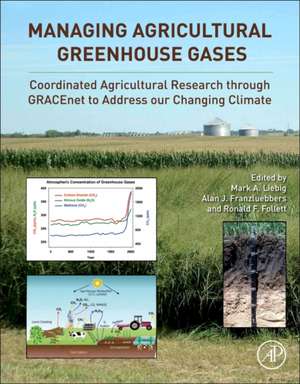Managing Agricultural Greenhouse Gases: Coordinated Agricultural Research through GRACEnet to Address our Changing Climate
Editat de Mark Liebig, A.J. Franzluebbers, Ronald F Folletten Limba Engleză Paperback – 5 iun 2011
- Frames responses to challenges associated with climate change within the geographical domain of the U.S., while providing a useful model for researchers in the many parts of the world that possess similar ecoregions
- Covers not only soil C dynamics but also nitrous oxide and methane flux, filling a void in the existing literature
- Educates scientists and technical service providers conducting greenhouse gas research, industry, and regulators in their agricultural research by addressing the issues of GHG emissions and ways to reduce these emissions
- Synthesizes the data from top experts in the world into clear recommendations and expectations for improvements in the agricultural management of global warming potential as an aggregate of GHG emissions
Preț: 475.24 lei
Preț vechi: 516.57 lei
-8% Nou
Puncte Express: 713
Preț estimativ în valută:
90.93€ • 95.20$ • 75.24£
90.93€ • 95.20$ • 75.24£
Carte tipărită la comandă
Livrare economică 29 martie-12 aprilie
Preluare comenzi: 021 569.72.76
Specificații
ISBN-13: 9781493301263
ISBN-10: 1493301268
Pagini: 536
Dimensiuni: 156 x 234 mm
Editura: ELSEVIER SCIENCE
ISBN-10: 1493301268
Pagini: 536
Dimensiuni: 156 x 234 mm
Editura: ELSEVIER SCIENCE
Public țintă
Research scientists working in agricultural and biogeochemical fields, soil scientists, agronomists, agricultural climatologists, scientists in climate science workgroups, conservation scientists, agricultural researchers at federal and state agencies and carbon footprinting consulting firms, advanced undergraduate/graduate students studying agricultural and climate science.Cuprins
Section One: Agricultural Research for a Carbon-Constrained World
- Agriculture and climate change: Mitigation opportunities and adaptation imperatives (Mark A. Liebig, Alan J. Franzluebbers, and Ron F. Follett)
- GRACEnet: Addressing policy needs through coordinated cross-location research (Charles L. Walthall, Steven R. Shafer, and Michael D. Jawson)Section Two: Agricultural Management and Soil Carbon Dynamics
- Cropland management in the eastern United States for improved soil organic C sequestration (Curtis J. Dell and Jeffrey M. Novak)
- Soil carbon sequestration in central USA agroecosystems (Cynthia A. Cambardella, Jane M. F. Johnson, and Gary E. Varvel
- Agricultural management and soil carbon dynamics: Western U.S. croplands (Harold P. Collins, Maysoon M. Mikha, Tabitha T. Brown, Jeffrey L. Smith, David Huggins, and Upendra M. Sainju)
- Soil carbon dynamics and rangeland management (Justin D. Derner and Virginia L. Jin)
- Soil organic carbon under pasture management (Alan J. Franzluebbers, Lloyd B. Owens, Gilbert C. Sigua, Cynthia A. Cambardella, and Richard L. Haney)
- Sustainable bioenergy feedstock production systems: Integrating C dynamics, erosion, water quality and greenhouse gas production (Jane M. F. Johnson and Jeffrey M. Novak)Section Three: Agricultural Management and Greenhouse Gas Flux
- Cropland management contributions to GHG flux: Central and eastern U.S. (Michel A. Cavigelli and Timothy B. Parkin)
- Management to reduce greenhouse gas emissions in western U.S. croplands (Ardell D. Halvorson, Kerri L. Steenwerth, Emma C. Suddick, Mark A. Liebig, Jeffery L. Smith, Kevin F. Bronson, and Harold P. Collins)
- Greenhouse gas flux from managed grasslands in the U.S. (Mark A. Liebig, Xuejun Dong, Jean E.T. McLain, and Curtis J. Dell)
- Mitigation opportunities for life cycle greenhouse gas emissions during feedstock production across heterogeneous landscapes (Paul R. Adler, Stephen J. Del Grosso, Daniel Inman, Robin E. Jenkins, Sabrina Spatari, and Yimin Zhang)
- Greenhouse gas fluxes of drained organic and flooded mineral agricultural soils in the United States (Leon Hartwell Allen, Jr.)Section Four: Model Simulations for Estimating Soil Carbon Dynamics and Greenhouse Gas Flux from Agricultural Production Systems
- DayCent model simulations for estimating soil carbon dynamics and greenhouse gas fluxes from agricultural production systems (Stephen J. Del Grosso, William J. Parton, Paul R. Adler, Sarah C. Davis, Cindy Keough, and Ernest Marx)
- COMET2.0 – Decision support system for agricultural greenhouse gas accounting (Keith Paustian, Jill Schuler, Kendrick Killian, Adam Chambers, Steven DelGrosso, Mark Easter, Jorge Alvaro-Fuentes, Ram Gurung, Greg Johnson, Miles Merwin, Stephen Ogle, Carolyn Olson, Amy Swan, Steve Williams, and Roel Vining)
- CQESTR simulations of soil organic carbon dynamics (H.T. Gollany, R. F. Follett, and Y. Liang)
- Development and application of the EPIC model for carbon cycle, greenhouse-gas mitigation, and biofuel studies (R.C. Izaurralde, W.B. McGill, and J.R. Williams)
- The general ensemble biogeochemical modeling system (GEMS) and its applications to agricultural systems in the United States (Shuguang Liu, Zhengxi Tan, Mingshi Chen, Jinxun Liu, Anne Wein, Zhengpeng Li, Shengli Huang, Jennifer Oeding, Claudia Young, Shashi B. Verma, Andrew E. Suyker, Stephen Faulkner, and Gregory W. McCarty)Section Five: Measurements and Monitoring: Improving Estimates of Soil Carbon Dynamics and Greenhouse Gas Flux
- Quantifying biases in non-steady state chamber measurements of soil-atmosphere gas exchange (Rodney T. Venterea and Timothy B. Parkin)
- Advances in spectroscopic methods for quantifying soil carbon (James B Reeves, III, Gregory W. McCarty, Francisco Calderon, and W. Dean Hively)
- Micrometeorological methods for assessing greenhouse gas flux (R. Howard Skinner and Claudia Wagner-Riddle)
- Remote sensing of soil carbon and greenhouse gas dynamics across agricultural landscapes (C.S.T. Daughtry, E.R. Hunt Jr., P.C. Beeson, S. Milak, M.W. Lang, G. Serbin, J.G. Alfieri, G.W. McCarty, and A.M. Sadeghi)Section Six: Economic and Policy Considerations Associated with Reducing Net Greenhouse Gas Emissions from Agriculture
- Economic outcomes of greenhouse gas mitigation options (David W. Archer and Lyubov A. Kurkalova)
- Agricultural greenhouse gas trading markets in North America (D.C. Reicosky, T. Goddard, D. Enerson, A.S.K. Chan, and M.A. Liebig)
- Eligibility criteria affecting landowner participation in greenhouse gas programs (Robert Johansson, Greg Latta, Eric White, Jan Lewandrowski, and Ralph Alig)Section Seven: Looking Ahead: Opportunities for Future Research and Collaboration
- Potential GRACEnet linkages with other greenhouse gas and soil carbon research and monitoring programs (John M. Baker and Ronald F. Follett)
- Elevated CO2 and warming effects on soil carbon sequestration and greenhouse gas exchange in agroecosystems: A review (Feike A. Dijkstra and Jack A. Morgan)
- Mitigation opportunities from land management practices in a warming world: Increasing potential sinks (J.L. Hatfield, T.B. Parkin, T.J. Sauer, and J.H. Prueger)
- Beyond mitigation: Adaptation of agricultural strategies to overcome projected climate change (Ronald F. Follett)
Recenzii
"...extremely well written and should be of interest to professionals as well as to advanced graduate students interested in agricultural GHG dynamics." --Journal of Environmental Quality
"Whichever discipline the reader may originate from, this book will provide a more holistic viewpoint of managing greenhouse gas emissions and carbon sequestration in agriculture. For researchers, industry professionals, and regulators, Liebig et al., who are associated with the US Department of Agriculture-Agricultural Research Service (USDA-ARS), synthesize research findings from about 30 ARS locations participating in the GRACEnet (Greenhouse gas Reduction through Agricultural Carbon Enhancement network) project. Contributed by USDA and other agricultural researchers mostly from the US, the 29 chapters describe the evaluation of agricultural carbon sequestration and greenhouse gas management, measurement, and modeling; economic and policy considerations for the short-term future; and long-term opportunities and the need for research collaborations. They discuss current trends in greenhouse gas emissions, agricultural contributions to those emissions, and risks associated with global climate change; background on the GRACEnet initiative; soil organic carbon dynamics for prevalent agroecosystmes in the US (cropland, rangeland, pasture, and biofeedstock production systems); the responses of carbon dioxide, methane, and nitrous oxide fluxes to management; five common ecosystem models for estimating SOC dynamics and greenhouse gas flux; key attributes of analytical methods used to estimate carbon change in soil and greenhouse gas flux; economic outcomes, incentive programs, and policy scenarios associated with reducing greenhouse gas emissions; and networks worldwide involved in climate change-related research." --Reference & Research Book News
"Whichever discipline the reader may originate from, this book will provide a more holistic viewpoint of managing greenhouse gas emissions and carbon sequestration in agriculture. For researchers, industry professionals, and regulators, Liebig et al., who are associated with the US Department of Agriculture-Agricultural Research Service (USDA-ARS), synthesize research findings from about 30 ARS locations participating in the GRACEnet (Greenhouse gas Reduction through Agricultural Carbon Enhancement network) project. Contributed by USDA and other agricultural researchers mostly from the US, the 29 chapters describe the evaluation of agricultural carbon sequestration and greenhouse gas management, measurement, and modeling; economic and policy considerations for the short-term future; and long-term opportunities and the need for research collaborations. They discuss current trends in greenhouse gas emissions, agricultural contributions to those emissions, and risks associated with global climate change; background on the GRACEnet initiative; soil organic carbon dynamics for prevalent agroecosystmes in the US (cropland, rangeland, pasture, and biofeedstock production systems); the responses of carbon dioxide, methane, and nitrous oxide fluxes to management; five common ecosystem models for estimating SOC dynamics and greenhouse gas flux; key attributes of analytical methods used to estimate carbon change in soil and greenhouse gas flux; economic outcomes, incentive programs, and policy scenarios associated with reducing greenhouse gas emissions; and networks worldwide involved in climate change-related research." --Reference & Research Book News












